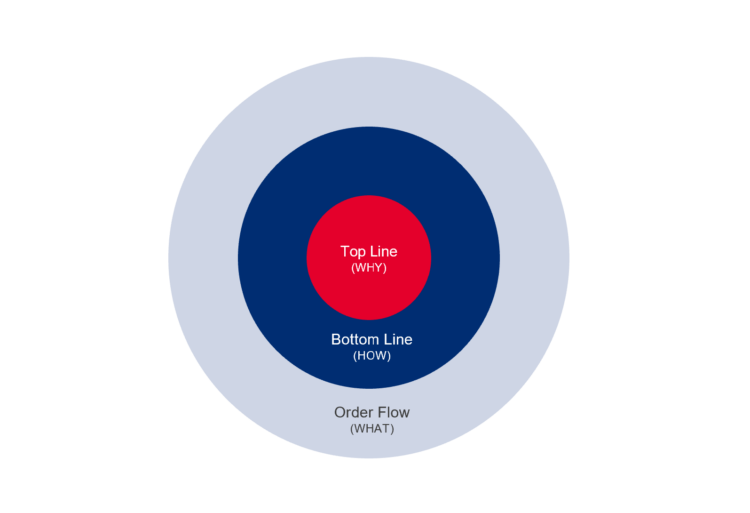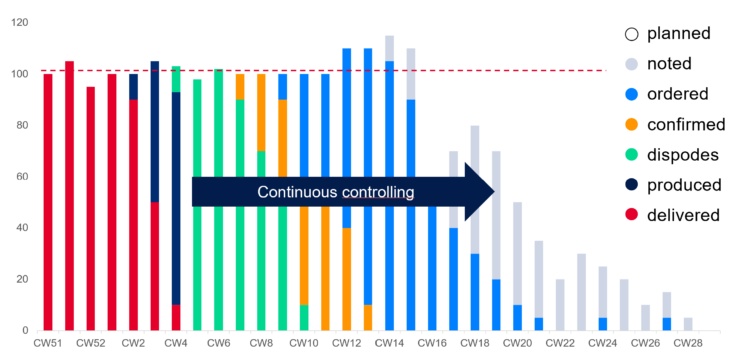
“Resilient companies are like round-bottomed tumbler dolls: they bounce back from any crisis upright and standing tall!”
Greater resilience in times of crisis: this is something that many companies would wish for at the moment. So how can resilience be strengthened in concrete terms? Drawing on his project experience, Dr. Andrej Fischer identifies three essential areas in which resilience can be bolstered.
When I was around five or six years old, I noticed a strange figure on my grandparents’ living room shelf. A little horse on a pedestal. When you pressed down in the right spot under the wooden platform, the little horse would slump down and lie tired and limp flat on the ground. When the pressure was taken off again, – whoosh – back on its feet again, standing as the proud, smiling little horse from before. I found this simple mechanism incredibly fascinating as a child and could easily spend hours playing with it.
Today, I am reminded of this little figure when I see how some companies emerge from crisis situations. They buckle for a brief period and then stand as proud and upright as the figure from my childhood days. They are resilient.
"Data-driven companies are comparatively resilient as these toys from yesteryear - they emerge upright from any crisis!"
How can resilience be strengthened in a targeted way?
Some companies succeed better than others when it comes to being resilient. Why is this so? What are these companies doing differently? There are many facets to economic resilience. In the different digitization projects that I have managed over the last few years, especially in manufacturing companies, I have been able to identify three areas in which data plays an important role when it comes to resilience. As a guide, the three areas can be assigned to the three levels of the so-called Golden Circle devised by Simon Sinek. The sequence is reversed here, however, somewhat as an exception, since these three development fields are usually also worked on in this order.
- Order flow: Resilience through rapid responsiveness to change (What)
- Bottom line: Economic resilience through operational excellence (How)
- Top line: Resilience through the development of new business areas (Why)

Order flow: fast responses in exceptional cases thanks to data & BI (control the “What”)
Resilient companies react quickly when the order situation or delivery conditions change. One example: When demand for certain foods among end customers declines due to seasonal factors, retail chains order fewer of these products from the manufacturer. The latter must now adjust their production and order quantities for raw materials and temporarily store or sell materials elsewhere. This is good example of how to stay resilient or respond resiliently by using your own data. The manufacturer can anticipate these large fluctuations by using historical sales data, business intelligence (BI) and, if necessary, AI forecasts. This means that the manufacturer is already prepared for these fluctuations and has scenarios in place to deal with the lack of sales. With the order intake and sales forecast always in sight, they are able to react at lightning speed. The same works in the other direction when sales suddenly increase. Since supply & sales planning is an elementary building block in the chain of overall corporate planning, this is one of the most important adjusting levers that can be used to improve a company’s resilience. The more accurately and farsightedly sales can be forecast, the more proactive planning can calm processes and make them efficient. But this also requires sophisticated data logistics, where data is available transparently and just in time across departments and systems. Only then will fast, data-driven decisions and flexible reactions become possible – a quick snap back like the bounce-back toys mentioned earlier on in the article.

Bottom line: Fundamental resilience achieved through process performance (mastering the “How”)
It is not only the ability to react quickly to exceptional situations that sets resilient companies apart. Transparent and high-performance processes in other core business areas also contribute to resilience. These can be used to conserve resources from the outset and promote basic economic resilience. This is precisely what happens with resilient companies – they make sure that their core processes such as order processing, costing, service and quality management or customer communication are maintained at a high level of performance. How do they manage to do this? One thing I have observed is that they are more focused than other companies on maintaining standards in the handling of data and treating it as a strategic resource. They continuously monitor all core processes (keyword BI) and thus subject them to a continuous improvement process (CIP). They ensure, if necessary with AI solutions, consistently high process, product and data quality levels in order to further enhance performance in the operating business. This clean data management is also a prerequisite for having all relevant information at hand for quick decisions in the event of an exceptional situation. In addition to a holistic data strategy, this also requires trust in data-driven processes and in decisions made with the help of AI. This is a form of trust that comes from transparency, quality assurance, and standards that follow the digital ethics guidelines. And ultimately, by involving all employees in the data topic – by increasing so-called “data competence” – they ensure that the entire organization is continually on the lookout for further ideas to contribute to process optimization.
Top line: Fit for the future with new business models (rethink the “Why”)
The third area in which corporate resilience is evident is the top line: the revenue generators of the future. The focus here is not on short-term measures to increase sales today, but on shaping the business strategically for the long term. Specifically, this focus here is placed on which business models and associated products and services will be relevant for business continuity in the coming years. Developing new business models is a creative process that should include as many options as possible. Many new options are emerging through the use of data and digital technologies. This is something that certainly makes it complicated, too. In this context, companies can take a systematic approach by asking themselves specific guiding questions. Questions like:

The following example, from a project I worked on with a printing company, illustrates what I mean by this:
- Key customer issues: Do retailers really need the print supplement, i.e., several tons of “colored paper”? Or is it not actually the advertising impact on end customers that really counts?
- Data monopolies: An agency responsible for running campaigns has exclusive information about which industries advertise where and when on which topics. This may be of great importance for retailers to better model their own sales.
- Information flow: To optimize campaigns, data is needed on regional media, its cost, advertising refusal rates, and sociography. Regional sales data of the retailer is also required. The task is to structure this flow of information, i.e., to provide data formats and exchange platforms.
- Services: Having a digital service that helps optimize online marketing measures while making the offline advertising that still exists measurable helps the advertising businesses and the producing companies behind them. A new offering is created that fits with the current and future developments within the market.
Moreover, some digital business models make future sales even more predictable, for example through subscription and as-a-service models, which has a favorable impact on order flow resilience.
When I think about my little horse, which had been in the cellar for such a long time, I realize all the more how resilient it was. Over all the years, it maintained its steadfastness – even taking on a new function as I use it as an analogy for this post. It has the kind of strength and versatility that I would hope to see in many companies.
Do you have any thoughts or questions on the resilience in business topic? Feel free to discuss this directly with Dr. Andrej Fischer and his colleagues: you can get in touch with them here.